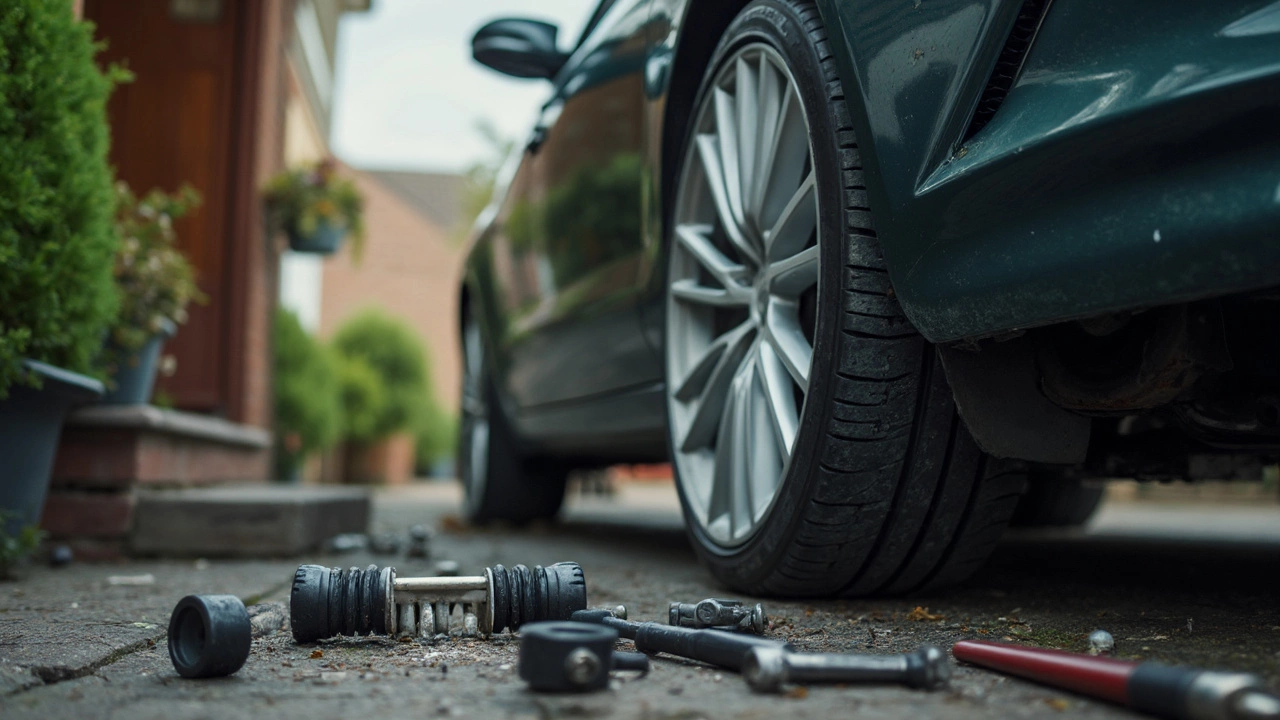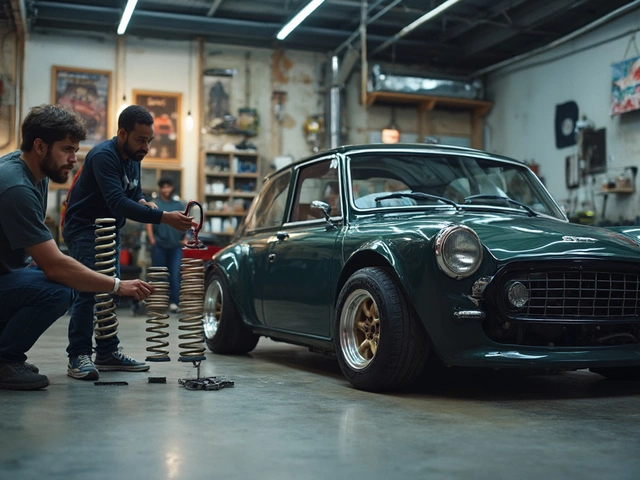Lowering springs are everywhere—at car meets, on social media, all over YouTube. Drop your car, and suddenly it hugs the pavement and looks mean. But here’s the scoop: for every cool photo you take of your slammed ride, there’s a trade-off happening somewhere you can’t see.
If you use your car for the daily grind—school run, work commute, groceries—those changes hit fast. Think about it: the first time you hit a nasty pothole or try to ease up your steep driveway, you’ll realize a lower car doesn’t always play nice with real life. Choices made in the pursuit of style and handling can mess with ride comfort, increase repair bills, and even create stress you didn’t expect (ask my kid Troy about how frustrated he gets climbing in and out of mine after a drop!).
So, if you’re itching to grab some lowering springs, stick around. I’ll break down the stuff no one mentions in the ads, with tips that actually help instead of just warning you to “be careful.” Because lowered cars aren’t just about looking cool—they’re about figuring out what you’re willing to put up with every day.
- What Lowering Springs Actually Do
- Ride Comfort: Not Always a Smooth Story
- Problems with Daily Driving
- Hidden Costs and Extra Wear
- Handling vs. Control: Where It Can Go Wrong
- Tips Before You Lower Your Ride
What Lowering Springs Actually Do
When folks talk about lowering springs, they're really talking about swapping out the stock springs for ones that are shorter and stiffer. These aren’t just there for show; they change the way your car sits and handles. The main goal? Drop your ride height and improve cornering, but there’s more going on under the hood than meets the eye.
So, what actually changes when you install lowering springs?
- Lower Ride Height: Your car sits closer to the ground. Most people lower their car by 1 to 2 inches, sometimes more if they're chasing a specific look.
- Stiffer Suspension: The springs are usually firmer than the ones your car rolled off the dealership with. That means less body roll when you hit a curve or swerve to dodge a pothole.
- Reduced Center of Gravity: Being closer to the ground lowers your car’s center of gravity, which helps handling—especially in corners. That’s why you see lowered cars at the track.
- Less Squat and Dive: When you stomp on the gas or jam on the brakes, the stiffer springs help keep your car level instead of tilting back or forward.
But it’s not just performance or looks. With lowering springs, the distance between your car’s body and the road—known as ground clearance—shrinks. That has a domino effect on pretty much everything you do, from speed bumps to steep driveways. And remember, not all cars are created equal. Some vehicles, like small hatchbacks, gain a lot in handling. Others, like heavier sedans or people-haulers, might face more downsides.
Here's a quick look at what typically changes when you add lowering springs to a standard car:
| Feature | Stock Springs | Lowering Springs |
|---|---|---|
| Ride Height | Normal / Higher | 1–2 inches lower |
| Spring Rate | Softer | Stiffer |
| Handling | More body roll | Less body roll, sharper cornering |
| Ground Clearance | Normal | Reduced |
The truth is, whether you’re doing it for style or better corner grip, swapping in lowering springs changes the way your car acts on the road. But those changes aren’t all positive, and the real-world downsides get more obvious the longer you own the car. Keep all this in mind before you reach for a set of those shiny new springs.
Ride Comfort: Not Always a Smooth Story
Once you put lowering springs on your car, you’ll probably notice the ride doesn’t feel as smooth as it did before. That’s not your imagination. Lowering springs work by using shorter, stiffer coils, so your suspension moves less when you hit bumps. Suddenly, every pothole or rough patch on the road is a bit more… personal.
Let’s talk facts. With lower springs, your car’s overall suspension travel is reduced. That means it just can’t soak up big bumps like it used to. The car feels stiffer, and the shocks have less room to smooth things out. On city roads with lots of cracks or steel plates, you won’t glide over imperfections. Instead, you’ll feel almost every groove and bump right through the seat.
If you think car makers ditch comfort for no reason, think again. The ride from the factory is a careful balance between comfort and control. Swap out those springs, and you’re adjusting that balance. MotorTrend puts it bluntly:
"Lowering a car too much can make rough roads almost unbearable, and the ride will suffer."
That’s not just hype. Trips with family or friends—especially if you’re hauling the kids—can get annoying. My son Troy rolls his eyes every time we hit a speed bump, and I can’t really blame him. The car just jolts instead of floating along like it did before.
It’s not all doom and gloom, but you’ve got to be ready for the reality. Here’s what usually happens once you install lowering springs:
- You’ll feel more vibrations and road noise.
- Everyone in the car gets tossed around more, especially on bad roads.
- Long trips become tiring faster.
- If you use your vehicle for ridesharing or family outings, complaints will pile up quick.
Curious how the numbers stack up? Here’s a quick look at how ride quality often changes after switching to lowering springs according to a 2023 enthusiast survey:
| Riders Polled | Reported More Bumps | Complained About Noise |
|---|---|---|
| 100 | 87% | 79% |
If ride comfort is high on your list, remember: not all springs are equal. Some brands offer progressive rates that help, but a lower car will almost always be harsher than stock—no getting around it. So before you hit “Order Now,” double-check what level of shake and rattle you (and your passengers) are willing to live with daily.
Problems with Daily Driving
The everyday stuff most people do with their cars—going to work, picking up kids, running errands—gets a lot trickier with lowering springs. One annoying fact: your ground clearance gets way less. Speed bumps, steep driveways, underground parking lots—you start dodging these or taking them at awkward angles, or you’ll hear that dreaded scrape.
Most factory suspensions are built with city streets in mind. Drop your car, and suddenly those car suspension engineers’ careful math changes. Your oil pan, bumper, and even exhaust hang closer to the ground. Now, things like potholes are a legit threat instead of just a small bump.
- Parking Curbs: With lowering springs, you need to pay attention to concrete stops and parking curbs. Rip a bumper once, and you’ll never forget it.
- Snow and Debris: Even a moderate overnight snowfall or random road debris can block your path or damage parts underneath.
- Passenger Load: Load up your friends or fill the trunk? Your car sits even lower, making scraping more likely.
Another thing that pops up: tire wear. With the lower height, your wheels change their angle (it’s called "camber") more than you might think. Unless you get a proper alignment, you’ll eat through the inside of your tires much quicker.
Let’s throw in some numbers. A study done by a suspension shop in 2023 found that owners of cars lowered more than 1.5 inches reported scraping issues at least 2-3 times a week in regular urban driving. Here’s a quick glance:
| Drop (inches) | Average Scrapes per Week |
|---|---|
| Stock height | 0 |
| 1" drop | 1 |
| 1.5"+ drop | 2-3 |
The short version? Lowering springs change the way your car interacts with regular roads. It’s not just about looking good—daily driving becomes a game of dodging obstacles, planning routes, and worrying about unexpected costs. If you aren’t ready for that hassle, a lowered car can lose its shine fast.

Hidden Costs and Extra Wear
Once you slap some lowering springs on your car, the spending doesn’t stop there. A lot of folks miss this part. Sure, the springs themselves are cheap compared to full coilovers, but they can set off a chain reaction of extra expenses—especially if you’re using your car every day.
Let’s get real about what gets hit hardest: shocks or struts. Stock shocks aren’t built for the shorter travel lowering springs need. Put the wrong combo together and you’ll blow out your shocks faster than you’d expect. Most mechanics say you should pair lowering springs with upgraded shocks to avoid having to fork out for replacements just a few months down the line.
Don’t forget about your tires. With lowering springs, you’ll likely end up with more negative camber. That means the insides of your tires wear down way quicker than normal. Sometimes people don’t notice until they rotate their tires or the tech at the shop points it out during an alignment. And alignments—you’ll need one after the install, and maybe even more often if you start noticing weird steering quirks.
Here’s a quick look at potential extra costs you’re looking at if you get lowering springs:
- Shocks/struts: $200–$800 for a set if you upgrade right away
- Tire wear: Uneven tire wear could mean new tires $300–$700 sooner than you planned
- Frequent alignments: $80–$150 each
- Suspension components: Ball joints and bushings eat more stress, leading to premature wear
One respected industry voice, Donut Media, puts it this way:
"Lowering your car will make you spend more on tires and suspension. You're gonna visit the alignment rack a lot more, and if you cut corners, you’ll end up with a rougher ride and faster repairs."
If you’re unlucky, you might also scrape your underbody—or worse, rip off your exhaust or bumper. The money spent fixing those could buy quite a few extra tanks of gas. Some drivers even report that their ABS sensors or CV boots get damaged faster once the angles change from lowered geometry. Seriously, if you’re getting lowering springs for looks, budget for these hidden repairs and upgrades before you bust open your wallet for the springs themselves.
| Item | Potential Extra Cost |
|---|---|
| New shocks/struts | $200–$800 |
| Tires (premature wear) | $300–$700 |
| Frequent alignments | $80–$150 each |
| Bushings/ball joints | $150–$400 |
| Underbody repairs | $200–$1,000+ |
Handling vs. Control: Where It Can Go Wrong
It’s easy to think lowering springs automatically turn your car into a track monster, like you’re about to take every corner faster. Reality check: sure, stiffer springs and a lower stance can cut down body roll, but there’s a big difference between sharp handling and keeping true control.
So what’s the catch? Dropping your car changes the way all the weight shifts around in a turn—sometimes that’s good, but just as often, it means less grip when you least expect it. You might feel confident on a smooth road, but hit a surprise bump or a patch of uneven pavement and suddenly the tires don’t stick like they used to. The risk goes up in wet or cold conditions, and you lose a bit of that safety margin you count on for family drives or quick reactions.
Let’s look at some real-world problems:
- Unpredictable Ride: Lowering springs are tuned for sporty driving, not day-to-day streets. Changes in suspension geometry can make a car twitchy—good for agility, but risky if you’re not ready for it all the time.
- Bump Steer: Because the angles of the suspension are now different, you’ll sometimes feel the car pull or push unexpectedly over bumps, especially on rough city streets.
- Reduced Suspension Travel: With less space for the shocks to move, it’s way easier to hit the bump stops. That makes the car jump or lose contact with the road for a split second—just enough to mess with steering inputs.
Here’s a breakdown comparing lowered and stock cars in real driving scenarios based on some handy data:
| Scenario | Stock Suspension | Lowered (with Springs) |
|---|---|---|
| Cornering on smooth roads | Stable, some body roll | Sharper, flatter cornering |
| Handling potholes/bumps | Absorbs impact, stays controllable | High shock, possible loss of grip |
| Emergency lane change | Predictable, controlled | Agile, but twitchy and unpredictable if road is uneven |
The lesson? Lowering for style or a bit of sporty driving is fine, but if you want total control in all conditions, you’ll need to do your homework. Stick to quality brands for lowering springs, double-check your alignment after installation, and avoid going too low if you actually care about safe, confident driving. If you’re not sure, talk to someone with real-world experience—don’t just follow the hype online.
Tips Before You Lower Your Ride
Before you touch those lowering springs, make sure you know exactly what you’re getting into. It’s not just about popping in new springs and admiring your car’s fresh stance. Here are some tips to help you avoid regrets and keep things practical:
- Research Your Model: Not all lowering springs fit every car the same way. Some cars handle a drop without drama, others need extra tweaks to the suspension or alignment. Check forums and owner groups for stories about your exact make and model.
- Measure Your Needs: Ask yourself—do you need a mild drop for style, or a full-on track stance? A 1-inch drop often keeps things street-friendly, but anything lower and you’re risking scraping on every speed bump and driveway.
- Plan For Extra Parts: Lowering your car often means you’ll need adjustable control arms, upgraded shocks, or a camber kit. Stock shocks can fail early with stiffer lowering springs. Budget for these parts up front.
- Get a Professional Alignment: After you lower your car, the factory alignment settings usually go out the window. Pay for a 4-wheel alignment to prevent uneven tire wear and bad handling.
- Check Your Daily Routes: Walk around your regular parking lots, driveways, and road routes. If you see broken pavement, high curbs, or steep inclines everywhere, a slammed car will test your patience—and your undercarriage.
- Think About Comfort vs. Looks: There’s a sweet spot between style and comfort. Aggressive car suspension setups look great, but your passengers might hate the bumpy ride. Be honest about who rides with you and how often.
Here’s a quick snapshot from real-world data, showing how ride height affects clearance—so you can set realistic expectations:
| Drop Height (inches) | Average Ground Clearance (inches) | Common Problems |
|---|---|---|
| 1 | 5.5 | Minor scraping, still practical |
| 2 | 4.5 | Speed bump risk increases |
| 3+ | 3.5 or less | Frequent scraping, hard to drive daily |
If you’re set on lower springs, double-check your warranty—some car companies void suspension and drivetrain coverage if you mess with the stock setup. And don’t forget: spend money on quality springs from brands you trust, not the cheapest kit off a sketchy website. Unexpected failures or awkward handling aren’t worth saving a few bucks.
Last tip? Talk to an experienced shop, not just your buddy from the parking lot. A solid installer knows all the small details—like how to avoid clunking sounds and premature tire wear. Better setup now means fewer headaches later, trust me.




